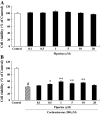Protective effects of piperine against corticosterone-induced neurotoxicity in PC12 cells
- PMID: 22205277
- PMCID: PMC11498508
- DOI: 10.1007/s10571-011-9786-y
Protective effects of piperine against corticosterone-induced neurotoxicity in PC12 cells
Abstract
Hyperactivation of the hypothalamic-pituitary-adrenal axis and the associated hippocampal atrophy were observed in patients with depression, which could be ameliorated by the treatment with antidepressants. Therefore, neuroprotection has been proposed to be one of the acting mechanisms of antidepressant. Our previous studies have showed that treating mice with piperine produced antidepressant-like effect in animal models of behavioral despair. This study aimed to examine the protective effect of piperine treatment on corticosterone-induced neurotoxicity in cultured rat pheochromocytoma (PC12) cells. The results showed that piperine co-treatment revealed a differential effect on the cytotoxicity of corticosterone and had its maximum inhibitory effect at 1 μM. Piperine (1 μM) co-treatment also significantly decreased intracellular reactive oxygen species level, and enhanced superoxide dismutase activity and total glutathione level in corticosterone-treated PC12 cells. In addition, piperine (1 μM) co-treatment was found to reverse the decreased brain-derived neurotrophic factor (BDNF) mRNA level caused by corticosterone in PC12 cells. The results suggest that piperine exerts a neuroprotective effect on corticosterone-induced neurotoxicity in PC12 cells, at least in part, via the inhibition of oxidative stress and the upregulation of BDNF mRNA expression. This neuroprotective effect may be one of the acting mechanisms accounts for the in vivo antidepressant activity of piperine.
Figures



Similar articles
-
Antidepressant like effects of piperine in chronic mild stress treated mice and its possible mechanisms.Life Sci. 2007 Mar 20;80(15):1373-81. doi: 10.1016/j.lfs.2006.12.027. Epub 2007 Jan 12. Life Sci. 2007. PMID: 17289085
-
[Antidepressant effects of piperine and its neuroprotective mechanism in rats].Zhong Xi Yi Jie He Xue Bao. 2009 Jul;7(7):667-70. doi: 10.3736/jcim20090712. Zhong Xi Yi Jie He Xue Bao. 2009. PMID: 19615322 Chinese.
-
Piperine reverses the effects of corticosterone on behavior and hippocampal BDNF expression in mice.Neurochem Int. 2014 Jul;74:36-41. doi: 10.1016/j.neuint.2014.04.017. Epub 2014 May 9. Neurochem Int. 2014. PMID: 24816193
-
A Systematic Review of the Anti-seizure and Antiepileptic Effects and Mechanisms of Piperine.Cent Nerv Syst Agents Med Chem. 2025;25(2):143-156. doi: 10.2174/0118715249297934240630111059. Cent Nerv Syst Agents Med Chem. 2025. PMID: 39082167
-
Potential Protective Effects of Pungent Flavor Components in Neurodegenerative Diseases.Molecules. 2024 Dec 2;29(23):5700. doi: 10.3390/molecules29235700. Molecules. 2024. PMID: 39683859 Free PMC article. Review.
Cited by
-
Hederagenin Protects PC12 Cells Against Corticosterone-Induced Injury by the Activation of the PI3K/AKT Pathway.Front Pharmacol. 2021 Oct 14;12:712876. doi: 10.3389/fphar.2021.712876. eCollection 2021. Front Pharmacol. 2021. PMID: 34721013 Free PMC article.
-
Malaysian macroalga Padina australis Hauck attenuates high dose corticosterone-mediated oxidative damage in PC12 cells mimicking the effects of depression.Saudi J Biol Sci. 2020 Jun;27(6):1435-1445. doi: 10.1016/j.sjbs.2020.04.042. Epub 2020 Apr 30. Saudi J Biol Sci. 2020. PMID: 32489279 Free PMC article.
-
Involvement of PI3K/Akt/FoxO3a and PKA/CREB Signaling Pathways in the Protective Effect of Fluoxetine Against Corticosterone-Induced Cytotoxicity in PC12 Cells.J Mol Neurosci. 2016 Aug;59(4):567-78. doi: 10.1007/s12031-016-0779-7. Epub 2016 Jul 13. J Mol Neurosci. 2016. PMID: 27412469
-
Arctiin Mitigates Neuronal Injury by Modulating the P2X7R/NLPR3 Inflammasome Signaling Pathway.Inflammation. 2025 Jun;48(3):987-1002. doi: 10.1007/s10753-024-02117-z. Epub 2024 Aug 17. Inflammation. 2025. PMID: 39154088
-
Study on the Neuroprotective Effects of Eight Iridoid Components Using Cell Metabolomics.Molecules. 2024 Mar 27;29(7):1497. doi: 10.3390/molecules29071497. Molecules. 2024. PMID: 38611777 Free PMC article.
References
-
- Aihara M, Ida I, Yuuki N, Oshima A, Kumano H, Takahashi K, Fukuda M, Oriuchi N, Endo K, Matsuda H, Mikuni M (2007) HPA axis dysfunction in unmedicated major depressive disorder and its normalization by pharmacotherapy correlates with alteration of neural activity in prefrontal cortex and limbic/paralimbic regions. Psychiatry Res 155:245–256 - PubMed
-
- Aydemir C, Yalcin ES, Aksaray S, Kisa C, Yildirim SG, Uzbay T, Goka E (2006) Brain-derived neurotrophic factor (BDNF) changes in the serum of depressed women. Prog Neuropsychopharmacol Biol Psychiatry 30:1256–1260 - PubMed
-
- Aydemir O, Deveci A, Taskin OE, Taneli F, Esen-Danaci A (2007) Serum brain-derived neurotrophic factor level in dysthymia: a comparative study with major depressive disorder. Prog Neuropsychopharmacol Biol Psychiatry 31:1023–1026 - PubMed
-
- Bachmann RF, Schloesser RJ, Gould TD, Manji HK (2005) Mood stabilizers target cellular plasticity and resilience cascades: implications for the development of novel therapeutics. Mol Neurobiol 32:173–202 - PubMed
-
- Bradford MM (1976) A rapid and sensitive method for the quantitation of microgram quantities of protein utilizing the principle of protein–dye binding. Anal Biochem 72:248–254 - PubMed
MeSH terms
Substances
LinkOut - more resources
Full Text Sources
Medical

